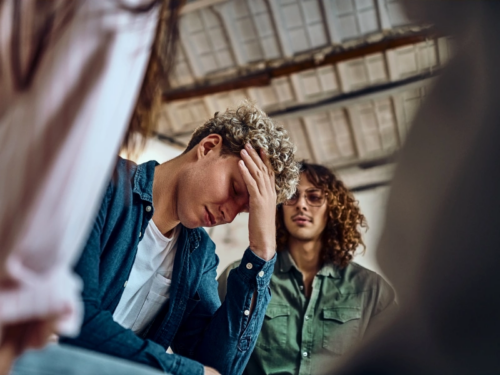
Table of Contents
Types of PTSD

Written By: Dr. Rasna Kaur Neelam

Clinically Reviewed By: Dr. Don Gasparini
August 25, 2023
7 min.
Post-traumatic stress disorder (PTSD), a debilitating mental health illness that impacts many Americans, exists on a continuum, meaning there are different types of PTSD. Keep reading to learn more about the different types of PTSD and the symptoms of each kind.
Learn more about our Clinical Review Process
Table of Contents
Post-traumatic stress disorder (PTSD) is a mental health condition that can begin after a person witnesses or experiences a traumatic event, including natural disasters, child abuse, war, sexual assault, and more. While there are some common signs of PTSD—intrusive thoughts, distressing flashbacks, and sleep disturbances (to name a few)—the condition exists on a continuum, meaning there are different types of PTSD, and symptoms can vary based on the specific diagnosis. If you or a loved one has experienced a traumatic event, keep reading to learn more about the different types of PTSD and the symptoms of each kind.
What are the different types of PTSD?
As mentioned, a person can develop different types of PTSD based on the specific nature of their traumatic experience. Some recognized types or subtypes of PTSD include uncomplicated PTSD, complex PTSD, and comorbid PTSD. While these subtypes can help clinicians understand and approach PTSD, the overarching diagnosis that someone will receive is still PTSD. Mental health clinicians diagnose PTSD and other mental health conditions using the Diagnostic and Statistical Manual of Mental Disorders (DSM-5), which classifies mental health conditions based on their symptoms and other diagnostic criteria. Below, we provide an overview of the different types of PTSD on the PTSD continuum and discuss the signs and symptoms of each type of PTSD.
Acute stress disorder
Uncomplicated PTSD
Complex PTSD
Comorbid PTSD
A diagnosis for people showing initial signs of PTSD lasting three days to one month.
The commonly understood form of PTSD characterized by flashbacks, nightmares, and intrusive thoughts that last for over a month following a traumatic event.
A form of PTSD caused by repeated traumatic incidents occurring over a long time period as opposed to one traumatic incident.
A diagnosis for people who meet diagnostic criteria for several mental health conditions at once, including PTSD.
Acute stress disorder
Acute stress disorder (ASD) is a diagnosis that describes people at an early risk of developing PTSD. According to the DSM-5, someone meets the criteria for ASD if they have had exposure to death, serious injury, or sexual violation and have PTSD symptoms lasting for at least three days but less than one month. When symptoms last longer than one month, a person is usually diagnosed with PTSD—an outcome that is seen in about half of people with ASD, according to the American Psychiatric Association.
The diagnosis of ASD allows people experiencing symptoms of PTSD to receive treatment as soon as possible. Treatment options, including therapy and medication, can help people with ASD manage their symptoms early and possibly prevent the progression of PTSD.
Example of ASD symptoms, diagnosis, and treatment
In the two weeks after his house is destroyed in a wildfire, a 12-year-old boy experiences nightmares, is withdrawn from his family, and is easily startled by the family dog. The child’s parents immediately notice these symptoms and enroll the child in therapy with a psychologist specializing in PTSD. Three weeks later, the symptoms have subsided. While the boy is still upset about what happened, his symptoms no longer stop him from participating in and enjoying day-to-day activities like showering, going to school, eating, and spending time with family.

Treating trauma is our specialty.
Personalized treatment to help you heal from home.
Uncomplicated PTSD
Uncomplicated PTSD is what is usually thought of when you hear the phrase PTSD. People with uncomplicated PTSD have experienced a traumatic event (firsthand or not) and experience symptoms like flashbacks, nightmares, and intrusive thoughts lasting longer than one month, according to the DSM-5. Within the category of uncomplicated PTSD, there are three common subtypes:
1. PTSD with delayed expression: Delayed onset or delayed expression PTSD is PTSD that does not meet full criteria until six months or later following a traumatic incident. Symptoms may develop earlier, but they do not reach the diagnostic level until several months have passed.
2. PTSD in those six and younger: Just like adults, children can experience trauma, including abuse, domestic violence, accidents, and more. And, just like adults, children can also experience PTSD symptoms, including intrusive thoughts, avoidant symptoms, and increased arousal. Clinicians use specific diagnostic practices to diagnose children with PTSD, like asking questions about symptoms that may be easier for children to answer.
3. PTSD with dissociative symptoms: Clinicians will often specify whether or not a person with PTSD has dissociative symptoms. Dissociating includes feeling detached from your brain or body (like you’re living in a dream), or feeling like the world around you is unreal or distorted.
Unfortunately, PTSD can last months to years. Several forms of therapy—including CBT, exposure therapy, and eye movement desensitization reprocessing therapy (EMDR)—can help treat PTSD.
Example of uncomplicated PTSD symptoms, diagnosis, and treatment
A 27-year-old veteran has recently returned home from abroad. Unfortunately, she witnessed many forms of violence while being deployed. At home, she has frequent flashbacks to the traumatic experiences she witnessed and often feels like she is watching herself from outside of her own body. She avoids interacting with close friends from the military and usually stays at home. She has started to feel more anxious and withdrawn, losing interest in hobbies like running and biking that she once enjoyed. After several months of feeling this way, her family finally encourages her to seek help. Through several months of exposure therapy, she starts to feel normal again but still sometimes feels on high alert and deals with depression.
Complex PTSD
Complex PTSD is not just caused by one traumatic incident but rather by repeated traumatic incidents occurring over a long time period. Examples of this may include being tortured as a prisoner of war or repeated physical and sexual abuse as a part of domestic violence. While complex PTSD is not a separate diagnosis listed in the DSM-5, many experts feel that the diagnosis of uncomplicated PTSD does not capture the full spectrum of complex PTSD symptoms. People with complex PTSD may experience all the symptoms of PTSD, plus the following symptoms:
- Feeling different from others
- Shame, guilt, or helplessness
- Becoming obsessed with or preoccupied with revenge
- Distrusting others
- Loss of a sense of meaning or purpose
- Dissociation (which can be seen in uncomplicated PTSD)
- Emotional dysregulation, including feeling extreme sadness, anger, or suicidal thoughts (if you’re experiencing suicidal thoughts and think you’re in danger of harming yourself, this is a mental health emergency. In this case, you should contact The Suicide & Crisis Lifeline by calling or texting 988.)
Just as with uncomplicated PTSD, complex PTSD has many treatment options, including therapy and medication. People with complex PTSD have often faced severe trauma and may have higher rates of dropout from therapy, meaning it is crucial to build a trusting relationship between the clinician and patient.
Example of complex PTSD symptoms, diagnosis, and treatment
A 25-year-old man was the victim of sexual abuse for several years in childhood and was abused by his husband in adulthood. After finally leaving his husband, this person isolates himself, refusing to speak with friends or family. He has flashbacks of his traumas, rarely leaves the house, avoids locations where he may see his family or ex-husband, feels a great deal of anger, and becomes fixated on harming those who have wronged him. He goes in and out of therapy for years but finally builds a trusting relationship with a trauma-informed clinician who helps him manage his complex PTSD symptoms.
Comorbid PTSD
Comorbid PTSD refers to people who meet diagnostic criteria for several mental health conditions at once. According to the DSM-5, people with PTSD are 80% more likely to have mental health conditions in addition to PTSD than people without PTSD. Common conditions that occur at the same time as PTSD include anxiety, depression, substance use disorder, and behavior disorders, including oppositional defiant disorder and conduct disorder.
Example of comorbid PTSD symptoms, diagnosis, and treatment
After surviving a car accident, a 16-year-old became addicted to pain medication and developed a substance use disorder. While talking to clinicians about their opioid use disorder, the teenager discloses that they experience recurrent flashbacks of the car accident, are afraid to drive or walk on busy streets and experience high levels of daily anxiety. After talking to a child psychiatrist, they are diagnosed with PTSD in addition to substance use disorder (comorbid PTSD) and can manage symptoms through therapy.

What are the common signs and symptoms of PTSD?
While there are several types of PTSD, as discussed, the following symptoms are involved in almost all forms of PTSD. If you or a loved one has experienced a traumatic event, pay special attention to this list to see if you recognize any of the symptoms in yourself or others.
- Recurrent intrusive memories of the traumatic incident
- Recurrent distressing dreams related to the traumatic event
- Dissociative reactions such as flashbacks that feel real
- Feeling as if the traumatic incident is occurring again
- Feeling down and feeling unable to experience happy emotions
- Having an altered sense of reality, for example, seeing yourself from someone else’s perspective
- Forgetting important details regarding the traumatic event
- Avoiding memories, thoughts, and feelings closely related to the traumatic incident
- Avoiding external reminders of the trauma, such as people or physical locations
- Sleep disturbances
- Hypervigilance
- Irritable behavior and angry outbursts, physical or verbal
- Difficulty with concentration
- Being very easily startled
PTSD treatment at Charlie Health
If you’ve been through trauma and don’t know how to handle the emotions or thoughts you’re experiencing, Charlie Health is here to help. Our virtual intensive outpatient program (IOP), provides several hours of virtual weekly care, including group, individual, and family therapy. Charlie Health’s licensed clinicians are trained in cognitive behavioral therapy, exposure therapy, and other modalities studied to effectively treat a wide range of PTSD subtypes. Fill out this short form to get started today.




